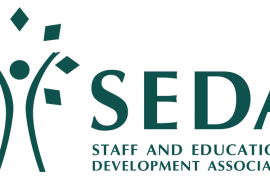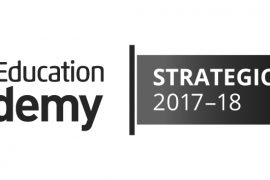The month’s highlights on higher education from across the web
1. How to Make Your Teaching More Engaging
How to Make Your Teaching More Engaging from The Chronicle
‘Student engagement’ is constantly bandied about across higher education. But how do we take small steps in achieving this in our own classrooms? This new and comprehensive resource from the Chronicle takes a fresh look at four evidence-based principles for increasing student engagement, with tips that you can use immediately and stories from those who have. From leveraging emotion, class-wide involvement, and sharing stories, there is something in here for every teacher and every classroom.
2. How to Build Meaningful Community for Online Learners
How to Build Meaningful Community for Online Learners from EdSurge
 Learning is wider than the individual and often involves a social connection that takes place beyond the confines of the individual mind. Building and belonging to a learning community is an important part of the learning process, providing motivation, support, and opportunities for connection and connecting knowledge. With an increasing shift towards blended and online learning environments, how can we create engaging and meaningful learning communities for online learners? This short article highlights some practical ways we can build and enrich our online learning environments. For more on this topic, you might also be interested in reading “I’ll see you on the discussion boards”: Tips for Engaging Students this Semester.
Learning is wider than the individual and often involves a social connection that takes place beyond the confines of the individual mind. Building and belonging to a learning community is an important part of the learning process, providing motivation, support, and opportunities for connection and connecting knowledge. With an increasing shift towards blended and online learning environments, how can we create engaging and meaningful learning communities for online learners? This short article highlights some practical ways we can build and enrich our online learning environments. For more on this topic, you might also be interested in reading “I’ll see you on the discussion boards”: Tips for Engaging Students this Semester.
3. How I Learned to Stop Worrying and Trust Students
How I Learned to Stop Worrying and Trust Students from The Chronicle
 How much do you trust your students? Rob Jenkins, writing in The Chronicle of Higher Education, argues that teachers are generally familiar with demonstrating their own trustworthiness through behaviour such as integrity and consistency, yet they are less inclined to show trust in their students. He has observed that demonstrating trust in students has a positive influence on behaviour, so if students believe that they are trusted they are more likely to behave in a trustworthy way. However, to achieve this teachers must relinquish some suspicious beliefs (e.g. students will do as little work as possible) and controlling behaviour (scrutiny, supervision and tighter rules). There may always be a minority of students that try to abuse the trust placed in them but Jenkins doesn’t believe in punishing the majority for that. On the contrary, pairing trust with accountability helps steer students towards the best decisions. The article outlines a number of ways that teachers can demonstrate trust in students and aid their maturation in areas of judgement, decision making and responsible behaviour.
How much do you trust your students? Rob Jenkins, writing in The Chronicle of Higher Education, argues that teachers are generally familiar with demonstrating their own trustworthiness through behaviour such as integrity and consistency, yet they are less inclined to show trust in their students. He has observed that demonstrating trust in students has a positive influence on behaviour, so if students believe that they are trusted they are more likely to behave in a trustworthy way. However, to achieve this teachers must relinquish some suspicious beliefs (e.g. students will do as little work as possible) and controlling behaviour (scrutiny, supervision and tighter rules). There may always be a minority of students that try to abuse the trust placed in them but Jenkins doesn’t believe in punishing the majority for that. On the contrary, pairing trust with accountability helps steer students towards the best decisions. The article outlines a number of ways that teachers can demonstrate trust in students and aid their maturation in areas of judgement, decision making and responsible behaviour.
4. How Can We Convince Students That Easier Doesn’t Always Mean Better?
How Can We Convince Students That Easier Doesn’t Always Mean Better? from The Chronicle
 In a world exploding with apps and technologies promising to make our lives easier, how do we convince students that the most effective ways to learn are not always the easiest? James Lang tackles this issue in the latest advice column for The Chronicle. With learning scientists now actively translating their finding on the best ways to learn into useful summaries and practical takeaways for students, academics, and parents alike, it seems that in order to have real impact we as teachers must not only consider “how do students learn best”, but also “how can we find ways to help students to follow the advice” and use what we know to their learning advantage.
In a world exploding with apps and technologies promising to make our lives easier, how do we convince students that the most effective ways to learn are not always the easiest? James Lang tackles this issue in the latest advice column for The Chronicle. With learning scientists now actively translating their finding on the best ways to learn into useful summaries and practical takeaways for students, academics, and parents alike, it seems that in order to have real impact we as teachers must not only consider “how do students learn best”, but also “how can we find ways to help students to follow the advice” and use what we know to their learning advantage.
5. The Distracted Classroom
The Distracted Classroom from The Chronicle
 The problem of distraction has infiltrated deep into our 21st century classrooms. Try as we might, many of us are at a loss on how we might face the challenges of distraction (digital or otherwise) in our classroom. This article, the first in a series of columns by James Lang on “The Distracted Classroom”, investigates the broader ideas behind distraction and attention. Distraction, Lang finds out, occurs “when we are pursuing a goal that really matters and something blocks our efforts to achieve it”. Read on and find out how we can use an understanding of distraction to help reshape our teaching practice and perhaps take the first steps towards dealing with (at least in part) the power of distraction.
The problem of distraction has infiltrated deep into our 21st century classrooms. Try as we might, many of us are at a loss on how we might face the challenges of distraction (digital or otherwise) in our classroom. This article, the first in a series of columns by James Lang on “The Distracted Classroom”, investigates the broader ideas behind distraction and attention. Distraction, Lang finds out, occurs “when we are pursuing a goal that really matters and something blocks our efforts to achieve it”. Read on and find out how we can use an understanding of distraction to help reshape our teaching practice and perhaps take the first steps towards dealing with (at least in part) the power of distraction.
6. Don’t Be Cruel [*from the archive]
Don’t be Cruel from The Chronicle
 Negative feedback has staying power. When giving feedback, it’s important not to underestimate the power of negativity or assume the worst about the person you are critiquing because, when it comes to negative feedback, the old mantra usually holds true: a little goes a long way. Too much, especially when applied without much thought for those on the receiving end, can easily discourage engagement, damage motivation, and increase anxiety – the opposite effect to what we are usually aiming for. While doling out unwarranted or insincere praise is not the answer either – this is often just as ineffective, if not quite as damaging – it does call for us to consider how we give feedback before we give it. While it takes time and mental energy to produce effective and constructive feedback, it is usually worth the effort.
Negative feedback has staying power. When giving feedback, it’s important not to underestimate the power of negativity or assume the worst about the person you are critiquing because, when it comes to negative feedback, the old mantra usually holds true: a little goes a long way. Too much, especially when applied without much thought for those on the receiving end, can easily discourage engagement, damage motivation, and increase anxiety – the opposite effect to what we are usually aiming for. While doling out unwarranted or insincere praise is not the answer either – this is often just as ineffective, if not quite as damaging – it does call for us to consider how we give feedback before we give it. While it takes time and mental energy to produce effective and constructive feedback, it is usually worth the effort.






